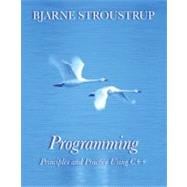
Note: Supplemental materials are not guaranteed with Rental or Used book purchases.
Purchase Benefits
What is included with this book?
| Preface | p. xxiii |
| Notes to the Reader | p. 1 |
| The structure of this book | p. 2 |
| A philosophy of teaching and learning | p. 6 |
| Programming and computer science | p. 12 |
| Creativity and problem solving | p. 12 |
| Request for feedback | p. 12 |
| References | p. 13 |
| Biographies | p. 14 |
| Computers, People, and Programming | p. 17 |
| Introduction | p. 18 |
| Software | p. 19 |
| People | p. 21 |
| Computer science | p. 24 |
| Computers are everywhere | p. 25 |
| Ideals for programmers | p. 34 |
| The Basics | p. 41 |
| Hello,World! | p. 43 |
| Programs | p. 44 |
| The classic first program | p. 45 |
| Compilation | p. 47 |
| Linking | p. 51 |
| Programming environments | p. 52 |
| Objects, Types, and Values | p. 59 |
| Input | p. 60 |
| Variables | p. 62 |
| Input and type | p. 64 |
| Operations and operators | p. 66 |
| Assignment and initialization | p. 69 |
| Composite assignment operators | p. 73 |
| Names | p. 74 |
| Types and objects | p. 77 |
| Type safety | p. 78 |
| Computation | p. 89 |
| Computation | p. 90 |
| Objectives and tools | p. 92 |
| Expressions | p. 94 |
| Statements | p. 99 |
| Functions | p. 112 |
| Vector | p. 116 |
| Language features | p. 123 |
| Errors | p. 131 |
| Introduction | p. 132 |
| Sources of errors | p. 134 |
| Compile-time errors | p. 134 |
| Link-time errors | p. 137 |
| Run-time errors | p. 138 |
| Exceptions | p. 144 |
| Logic errors | p. 152 |
| Estimation | p. 155 |
| Debugging | p. 156 |
| Pre- and post-conditions | p. 161 |
| Testing | p. 164 |
| Writing a Program | p. 171 |
| A problem | p. 172 |
| Thinking about the problem | p. 173 |
| Back to the calculator! | p. 176 |
| Grammars | p. 186 |
| Turning a grammar into code | p. 193 |
| Trying the first version | p. 201 |
| Trying the second version | p. 206 |
| Token streams | p. 207 |
| Program structure | p. 213 |
| Completing a Program | p. 219 |
| Introduction | p. 220 |
| Input and output | p. 220 |
| Error handling | p. 222 |
| Negative numbers | p. 227 |
| Remainder | p. 228 |
| Cleaning up the code | p. 231 |
| Recovering from errors | p. 238 |
| Table of Contents provided by Publisher. All Rights Reserved. |
The New copy of this book will include any supplemental materials advertised. Please check the title of the book to determine if it should include any access cards, study guides, lab manuals, CDs, etc.
The Used, Rental and eBook copies of this book are not guaranteed to include any supplemental materials. Typically, only the book itself is included. This is true even if the title states it includes any access cards, study guides, lab manuals, CDs, etc.